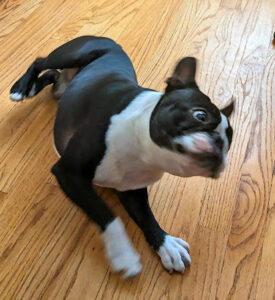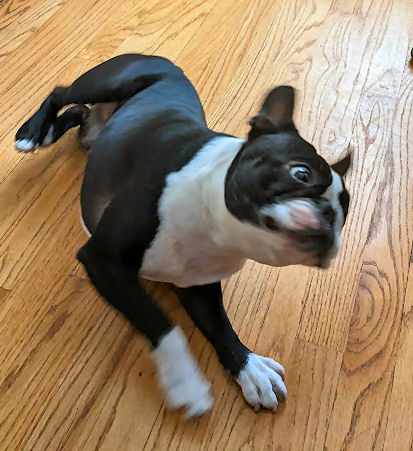Treat your dog’s symptoms. You can’t know the cause.
It’s a harsh truth all dog owners must face. You’ll never know why your dog does some stuff they do. They’ll never tell. Even if you’ve known your dog since they were born, you can’t know what they’re thinking so you have to treat your dog’s symptoms.
Most of us get pretty good at reading our dogs’ unique signs and patterns. The good, the bad, and the silly. We’re pretty convinced that potty-training dogs is a combination of teaching the dog and starting to recognize your dog’s signs that urgent action is required.
Since you can’t know the “why,” you’re left to deal with treating the symptoms of your dog’s quirks.

Some don’t matter. We have no idea why Simon, Fran’s six-year-old Boston Terrier, thinks he can dry himself on the hardwood floors. He runs around rubbing himself on the floors as if there were moisture-wicking properties in wood. He does it every time he comes inside from the rain. It’s weird. But it’s harmless. We ignore it, other than to watch him, thinking how strange it is.
Not so benign
Other behaviors aren’t so benign. The dog of a training student of ours started growling and showing teeth to her 13-year-old son. The dog was only recently adopted as an almost-two-year-old. She’ll never be able to tell us why she was feeling threatened by that son, one of four in the family. But she was, so we developed a plan to treat the symptom. That son now hand-feeds the dog her dinner, plays training games with her, and always interacts positively with her.
In this case, sharp observation also helped. The owner noticed that this son was the only one who constantly wears a hoodie with the hood pulled over his head. When the son didn’t have the hood up, the dog was fine. Why is the dog threatened by people in hoodies? We’ll never know. And she’ll never tell us. We treat the symptom and gradually let the dog learn that hoodie-wearing people are okay.
Deal with the quirks
Some people think dogs are dogs. That dogs are interchangeable. We recently spoke to someone who called about classes. She urgently needs help training her 13-month old Bernese Mountain Dog / Poodle cross breed dog. In the conversation, she mentioned that her current dog isn’t anything like the dog she lost, a Labrador Retriever. Of course not. They’re completely different kinds of dogs. She said she’d thought a dog was a dog. As if only the color, size, and fur differed among dogs.
Every dog, like every person, is a unique individual. Unlike people, we have no way of communicating in words with our dogs. We can never get explanations of why they do what they do. We can only deal with and train the symptoms.
Watch for when
If your dog has a behavior that needs to be turned around, notice when it happens. And where. What’s going on that might have triggered it? You may not hit the nail on the head right away. But knowing how to play training games has given you the ability to break things down into small chunks. Experiment with the circumstances that trigger your dog’s unwanted behavior. When you hit on something that may be a factor, you’ll know where to start training.
In the case of the dog fearing the hoodie, they’ll start with a sweatshirt by itself. Let the dog check it out. Sniff it. Paw at it. When she no longer reacts at this stage, the son can put it on (without the hood up), sit quietly, and give her treats for being close. When she’s okay with that, he can fold up the hood a bit at a time. Step by step, treating the symptom.
We had another student whose Great Dane puppy wouldn’t go for walks without their older dog. He stopped dead in the driveway and refused to move. We’ll never know why solo walks were scary. Treat the symptom. Start even with the older dog and gradually let him (and the person walking him) lag behind. Over time, the distance will increase to the point that they’re not walking together at all. Treat the symptom.







